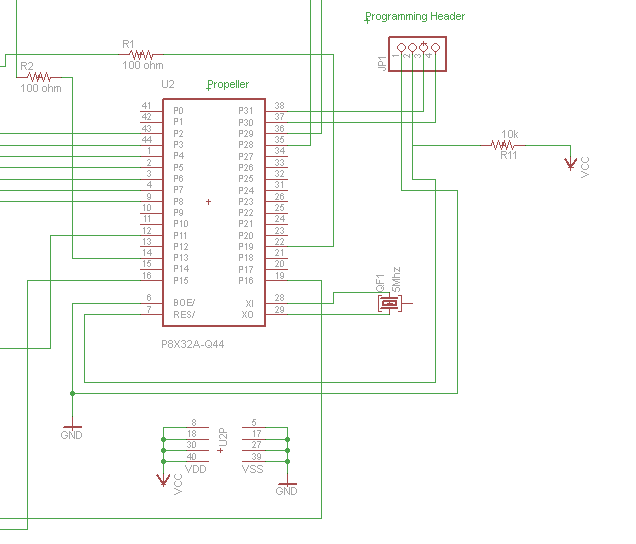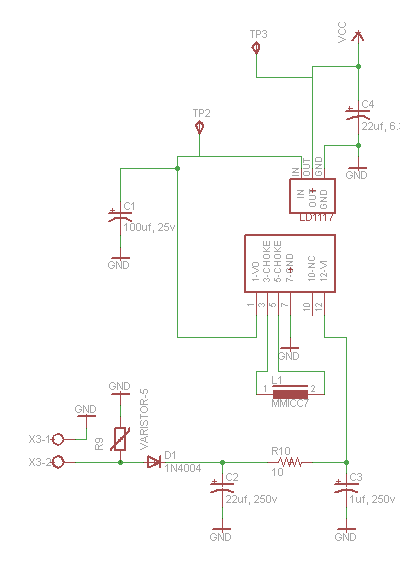Prop Plug trips GFI
Hello everyone,
I have had a bit of a problem I am having a difficult time understanding. I have designed a board with a Propeller, EEPROM, XBee with an AC power supply with an on board AC/DC power converter. When I power the board from my 3.3v test point, the board programs via a prop plug correctly and works everything works as expected. However, when I power the board in via AC, it also works correctly (the Prop code runs correctly), EXCEPT that when I plugin in the prop plug GFI I am plugging my board into trips.
I am a little confused as to why this might be. Do I need to isolate my AC and DC sides better? Is there a diode I need somewhere to limit the connection to GND?
Power Schematic

Programming Header Schematic

Any help or suggests on how to address this problem is greatly appreciated.
Cheers,
Gregg
I have had a bit of a problem I am having a difficult time understanding. I have designed a board with a Propeller, EEPROM, XBee with an AC power supply with an on board AC/DC power converter. When I power the board from my 3.3v test point, the board programs via a prop plug correctly and works everything works as expected. However, when I power the board in via AC, it also works correctly (the Prop code runs correctly), EXCEPT that when I plugin in the prop plug GFI I am plugging my board into trips.
I am a little confused as to why this might be. Do I need to isolate my AC and DC sides better? Is there a diode I need somewhere to limit the connection to GND?
Power Schematic

Programming Header Schematic

Any help or suggests on how to address this problem is greatly appreciated.
Cheers,
Gregg


Comments
Isolating either power supply should stop the GFI tripping. Switching to a laptop with a brick switching power supply will probably do the trick, as would putting either device on an isolation transformer.
I will try both of these for learning, I will isolated circuit via a transformer and order a galvanic isolated AC/DC converter to play with.
Thanks!
Gregg
Thanks again,
Gregg
Like two pieces of equipment both with isolated supplies connected via RS485/422 that immediately fails blowing the driver chips. And that's two units within the same cabinet connected to the same mains power point. Turns out that ground on one end is flying up and down -60v to +60v at mains frequency w.r.t. the other.
Quite how that happens I never figured out.
Thanks for the explanation guys! Helped so much!
Cheers,
Gregg
The manufacturers have justified not using isolation transformer by building in plastic cases that are suppose to completely isolate the user from any shock hazard. But the hobbyist just jumps in with bare boards and not much knowledge of sane safety proceedure.
When in doubt, it just might be wisest to power bench work from a battery and not have anything connected to the house mains.
Yes, in the USA that is true. UL approval is generally observed.
But in Asia, we get the other wallwarts -- those that never were allowed import to the USA or EU. And some of these may be making it to the USA and EU via EBay sales. China produces a lot of electronics for export that go to other destination where safety compliances are not so rigorous.
I just know that an isolation transformer is a very good thing, regardless of other safety proceedures. I have just been zapped too often from the lack of isolation. Everyone working with bare board projects that are powered by AC mains should acquire some awareness of safety proceedures.
If you are relying on a grounded metal case for 'double insulation' safety protection, you should generally not poke around inside it when the power is on.
+++++++++++
A lot of the 'culture of safety' is taken for granted by western cultures. But people over here are still catching up.
Recently we had a crane collapse of a 300 ton lift in Taipei and complete crush a passing car. It was obvious that the crane operator had inadequate training and there was no plan for traffic control. Electrical house wiring here is nowhere near US standards of safety.
If you are going to globally source cheap electronics components, it helps to be aware of holes in safety complicances.